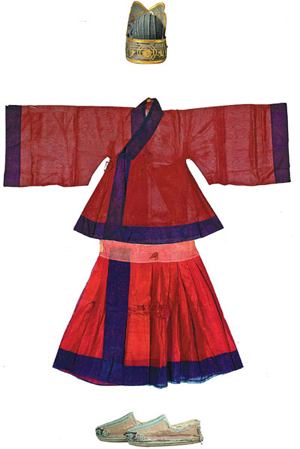
|
|
|
 |
||
| A dress worn by the Empress Dowager Ci Xi of the Qing Dynasty | A painting of Ci Xi in casual dress | |
| A fox-fur overcoat worn by Emperor Qianlong of the Qing Dynasty | A painting of Qianlong in the fox-fur overcoat | |
| It is perhaps the world's only complete set of Ming court clothing. It consists of a five-beamed crown, red silk court robe, red silk skirt, white silk inner garment and a pair of bright red shoes with green lining and cloud patterns. The crown is the only one of its kind, although its pin and tassel is missing. More... | Dressed like nobility
Ming Dynasty (1368-1644) clothes belonging to Confucius' aristocratic descendants are among the best-preserved of the era and offer hints of lost textile arts. More... | |
|
|
|
Han Dynasty |
Ming Dynasty |
Qing Dynasty |
Modern Qipao |
|
The Ming clothing is representative of the ethnic Han's ancient style, which is loose and elaborate. The Qing clothing is of traditional ethnic Manchu tailoring, which is tight-fitting with narrow sleeves, as the Qing rulers were ethnic Manchu, whose soldiers spent their lives riding horses and hunting. The Qing Dynasty's takeover from the initially replaced the Ming-era's loose and flowing robes with saddle-shaped collars and U-shaped sleeves with semicircular cuffs. The saddle-shaped collar protected their faces and is the prototype of the stand-up collar of the cheongsam (qipao). The Qing robes' high cuts developed into the cheongsam's signature style in the 1920s. More... | |||
| Red satin shoes with hoof-shaped soles in Qing Dynasty | A square patch with a partridge for eighth-rank officials in Qing Dynasty | |||
| Accessories in Qing Dynasty |
A rattan crown stitched with nine strings, each string with nine jade beads in Ming Dynasty |
A robe with golden-threaded dragon roundels |
|
|
| The wow of qipao | Garments in late Qing Dynasty | Garments in Qing Dynasty | Garments in Qing Dynasty | Emperor's concubines in Qing Dynasty |
|
|
|
| Cheongsam show in Shanghai | Models present 'Huafu' dresses in Berlin, Germany |
Editor: Bi Nan